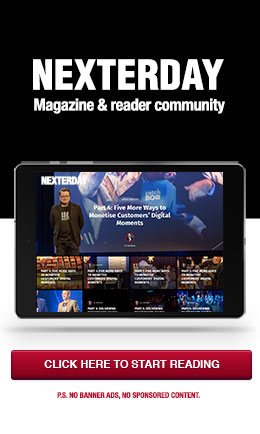Q3 2012: An Update on Comptel’s Business and Strategy
Posted: October 23rd, 2012 | Author: Juhani Hintikka | Filed under: News | Tags: analytics, business, Comptel, Comptel Fulfillment, mediation, Social Links, strategy | Comments Off on Q3 2012: An Update on Comptel’s Business and StrategyLast week, we announced Comptel’s financials for the third quarter of 2012, which proved that our earlier focus on cost containment is quickly showing results. This quarter was ripe with strong sales, bringing the company back to profitability, and I am very pleased to show revenue growth in all of Comptel’s areas of business.
We won two significant projects from South America – one is outside of our traditional domain, from a Brasilian utility company that purchased Comptel Fulfillment, and the other is with Telefonica Argentina that continued to consolidate its mediation systems with Comptel. Reinforcing our position as a powerful analytics vendor, we also closed a Comptel Social Links deal with a prominent operator group in the Middle East. In addition, there was a considerably large sized managed service deal, and a few larger upgrades of Comptel Mediation and Comptel Fulfillment contracts from existing customers.
As anticipated, the operating result for the third quarter was positive. We met the cost-savings targets set in June, and the cost level for this quarter was significantly lower compared to the first half of the year. Now, it is time to move forward following the regrettable personnel-related efficiency measure we completed during the quarter and continue the execution of our strategy. We’re confident that we’re moving in the right direction and are further improving the integration of our analytics capabilities and striving to deliver on our corporate values.
One of our goals is to become the leader in customer interaction automation for telecommunications, and we’re also looking to expand this outside of our traditional domain. This will ultimately have an impact on our sales and marketing strategy, which will both be aligned with the approach, as the role of our partners will become even more important. In order to implement the new sales and marketing approach, we decided to build a strong team of sales executives, headed by the newly established role of Chief Market Operations Officer (CMO), who will take the lead in this transformation. At the same time, we also simplified our Executive Board to ensure the organisation is as efficient as possible and can successfully execute the strategy.
Overall, the third quarter of 2012 has been quite busy. Maybe the best way to sum up this quarter is to simply reiterate how I concluded the last quarter: I’m honoured to convey, on behalf of Comptel, that we are looking forward to continuing to deliver on our promises to the market in the fourth quarter of 2012.
The True Value of Big Data
Posted: October 19th, 2012 | Author: Matti Aksela | Filed under: Industry Insights | Tags: big data, communication service providers, contextual predictive analytics, CSP, median and fulfillment, policy management, predictive analytics, value, variety, velocity, volume | 1 Comment »There’s no denying that one of the biggest trends in IT right now is Big Data. While there are many different ways to describe it, perhaps the most commonly agreed upon, and my personal favorite, is that it must encompass the three “Vs”: volume, velocity and variety. How organisations understand and embrace these concepts varies—but I think we can all agree on one thing – there is a lot of data being generated quickly from various sources. I’ve found that one of the biggest questions organisations are asking though (which adds a fourth “V” to the equation) is: How do we derive value from Big Data?
Real-time (or near real-time) predictive analytics are gaining in popularity, and may hold the key to realising Big Data’s true value. In his keynote presentation at OpenWorld, Joe Tucci, CEO of EMC Corporation, stated that: “Real-time predictive analytics will be the killer app for this cloud era.” Personally, I could not agree more and think that this points in precisely the right direction, not just for cloud but for all businesses dealing with data.
One of the main benefits is gaining a strategic understanding of customers and the overall business ecosystem. But the key is going beyond simply collecting information, or even the ability to store and process it. The way organisations can truly realise Big Data’s potential is by leveraging it to predict behaviours and market changes, and make smarter business decisions based on that knowledge.
What exactly those actions are will depends a bit on the case—for communications service providers, it may be policy management activities or real-time, location-based marketing campaigns. And as many are already noticing, decision-making with predictive modeling can have huge benefits.
In short, I believe we must indeed look at Big Data not as a thing that happens, but as a process we act upon – through contextual predictive analytics-driven actions. Enabling these insights is important to Comptel and something we’re continually working towards by combining analytics with our high-performance mediation and fulfillment platform. If I must confess, I am really excited about what we are seeing and doing here, and the benefits we can offer to our customers!
Reflections on My Trip to Kazakhstan
Posted: October 17th, 2012 | Author: Juhani Hintikka | Filed under: Events | Tags: Bayterek Monument, Business Team Finland, Communications Service Provider, Comptel, CSP, Europe East, Finland, ICT, Kazakhstan | 1 Comment »Almaty
I recently had the honour of travelling to Almaty to lead the largest ever Finnish-Kazakhstani business delegation regarding trade and economic cooperation. Ninety representatives from 55 companies were involved in addition to Finland’s minister for European affairs and foreign trade, Alexander Stubb, and other high-ranking officials. Altogether, 13 business sectors were represented; the information and communications technology (ICT) team consisted of TeliaSonera, Nokia Siemens Networks and Comptel.
At the delegation, the key priorities outlined were attracting Finnish investments into the Kazakhstan economy and furthering innovation and new technologies between the two regions. What’s interesting is that, for the past ten years, Kazakhstan has been the third, fastest growing economy in the world after China and Qatar.
We also had the opportunity to meet with both communications service provider (CSP) KCell (a customer of Comptel’s) and Minister Stubb, which certainly proved to be a highlight of the trip. Our head of Europe East, Timo Koistinen, with regional sales director, Sergey Biryukov, accompanied me in a tournament, trying to meet all of the local service providers and naturally network with the other delegation attendees. Timo and Sergey succeeded in speaking to the other three CSPs in the region, KazakhTelecom, Tele2 and Beeline, first, and since they moved so fast, they also experienced the “magic touch”—the hand of the president of Kazakhstan on the top of the Bayterek Monument in Astana. My schedule was very tight with several meetings to ensure the whole trip went smoothly for the whole Business Team Finland.
In all, this type of event is an excellent way of promoting Finland abroad. I’m confident that many of us succeeded in building new relationships with the companies in the region while networking with our Finnish business colleagues.
“Minding” Your Own Business
Posted: October 11th, 2012 | Author: Andrew Gavin | Filed under: Events, Industry Insights | Tags: Africa, analytics, CIQ4T, contextual intelligence | Comments Off on “Minding” Your Own BusinessA few months ago in a blog where I discussed the need for more service personalisation, I admitted that it was tough for operators to engage effectively on a more personal level because I myself “don’t always know what I want until after I have experienced it – or what I had is taken away” …
I also, however, suggested that it is possible and operators should be empowered with “mind-reading abilities”!
Let me illustrate with a totally non-OSS related example: my 6 year old son. Unlike a lot of his friends (and his parents), he is totally disinterested in food. However, over the years, we have observed that when he gets hungry, he starts to get unreasonable and emotional. He never says he is hungry or asks for food, but we have learned that when he starts behaving that way and he has not eaten for a while, that giving him a snack returns him to his usual good natured self.
In this example, my son apparently does not know what he wants or needs (un-communicated needs) – and feeding him any other time is of course pointless too (context).
So we:
1. Learned (and re-learned) this behaviour using our human intelligence i.e. we do not use a list of rules to identify the situation;
2. We take into account the context i.e. when he last eat or whether his sister had just bitten him again;
3. We act then and when it is needed.
And this is a pretty good example of the “mind-reading” capabilities Comptel’s Contextual Intelligence for Telecommunications (CIQ4T) can offer operators: LEARN, examine the CONTEXT (in real-time) … and ACT.
I will be manning the stand for Comptel (C05) at AfricaCom in Cape Town from the 13th-15th November and would love to discuss further how Comptel can provide operators with “mind-reading” abilities for more personalised customer engagement.
Network Modernization
Posted: October 5th, 2012 | Author: Martin Vieth | Filed under: Industry Insights, Telecom Trends | Tags: Asia, customer experience, OSS/BSS | 1 Comment »More on the Catalog Conundrum
Posted: October 2nd, 2012 | Author: Steve Hateley | Filed under: Industry Insights | Tags: 4G, business operations, catalog, communications service providers, CSPs, OSS/BSS, product lifecycle management, Service Provider IT, SPIT | Comments Off on More on the Catalog ConundrumWhile some are still a bit hesitant to adopt a service-layer catalog, we’re seeing communications service providers (CSPs) use it more and more as a driver for their overall business operations. This is especially true as service portfolios become broader, and as CSPs realise that simple commercial product catalogs can’t deliver the agility and rapid deployment needed to help them effectively compete. I recently wrote about this and the various benefits catalog can bring to CSPs, especially in terms of making product lifecycle management more efficient. Now, I’d like to dive a bit deeper into why catalog initiatives are a must for service provider IT (SPIT).
Catalog has traditionally played a role in many proof-of-concept exercises, as it can make product development and deployment easier, faster and less expensive. However, most CSPs haven’t followed these ideas through to operational adoption. This is starting to change as emerging technologies are fuelling the need for new tools to manage product lifecycles, and increasing organisational complexity only adds to this need. Meaning, CSPs must manage converging technologies and dispersed capabilities across departmental and service boundaries, which demand that formal management of the service lifecycle be a key part of the OSS/BSS architecture – cue catalog.
While CSPs realise the need for progress, one of the biggest obstacles they face in shifting to a catalog-driven approach is fear of transformation and the subsequent impact on existing processes. Alleviating these fears may be as simple as introducing catalog in phases to various departments rather than to the entire organisation at once. It’s important to think about the longer term benefits, too. CSPs can realise substantial architecture paybacks by integrating a system that wraps and re-uses its legacy infrastructure with new catalog-driven models.
When considering the investments being made in various technologies like 4G, coupled with the demand for personalised product delivery, catalog initiatives seem essential for management and have the potential to ensure true differentiation in the market. There is a very real possibility that the traditional OSS/BSS boundaries and architectures of the past will be completely redrawn, with service catalogs at the centre of the new SPIT platform. Do you agree?





